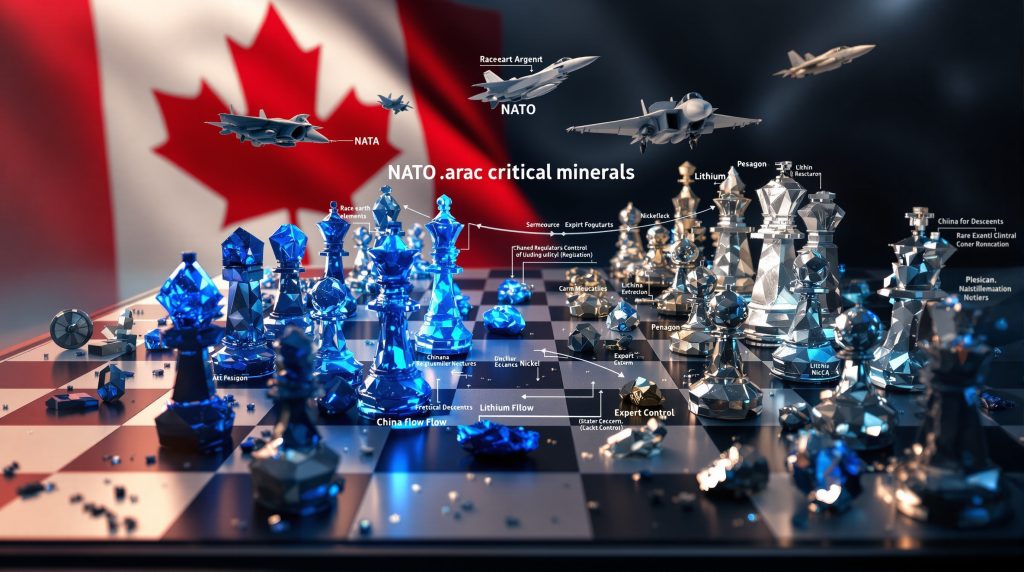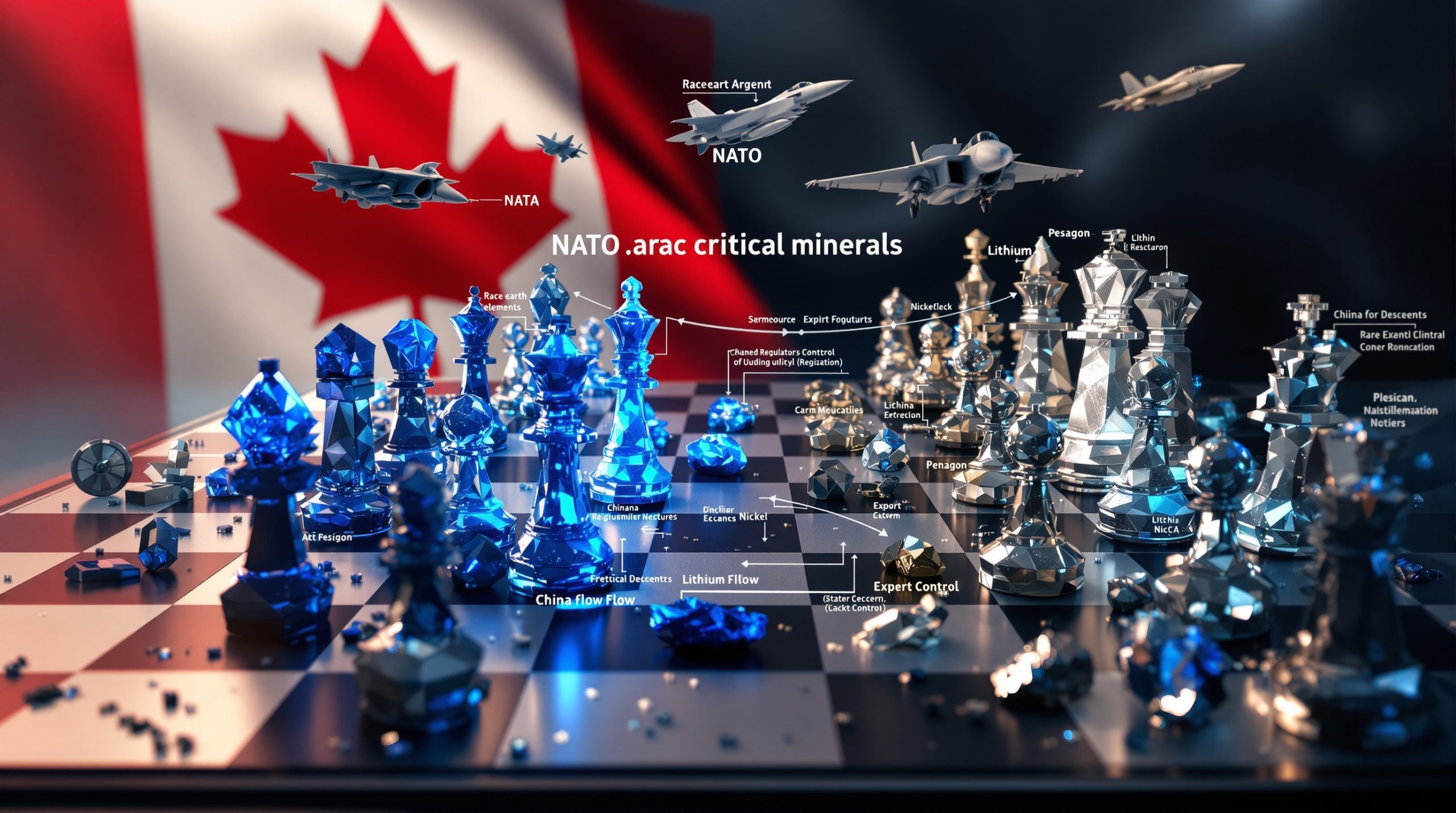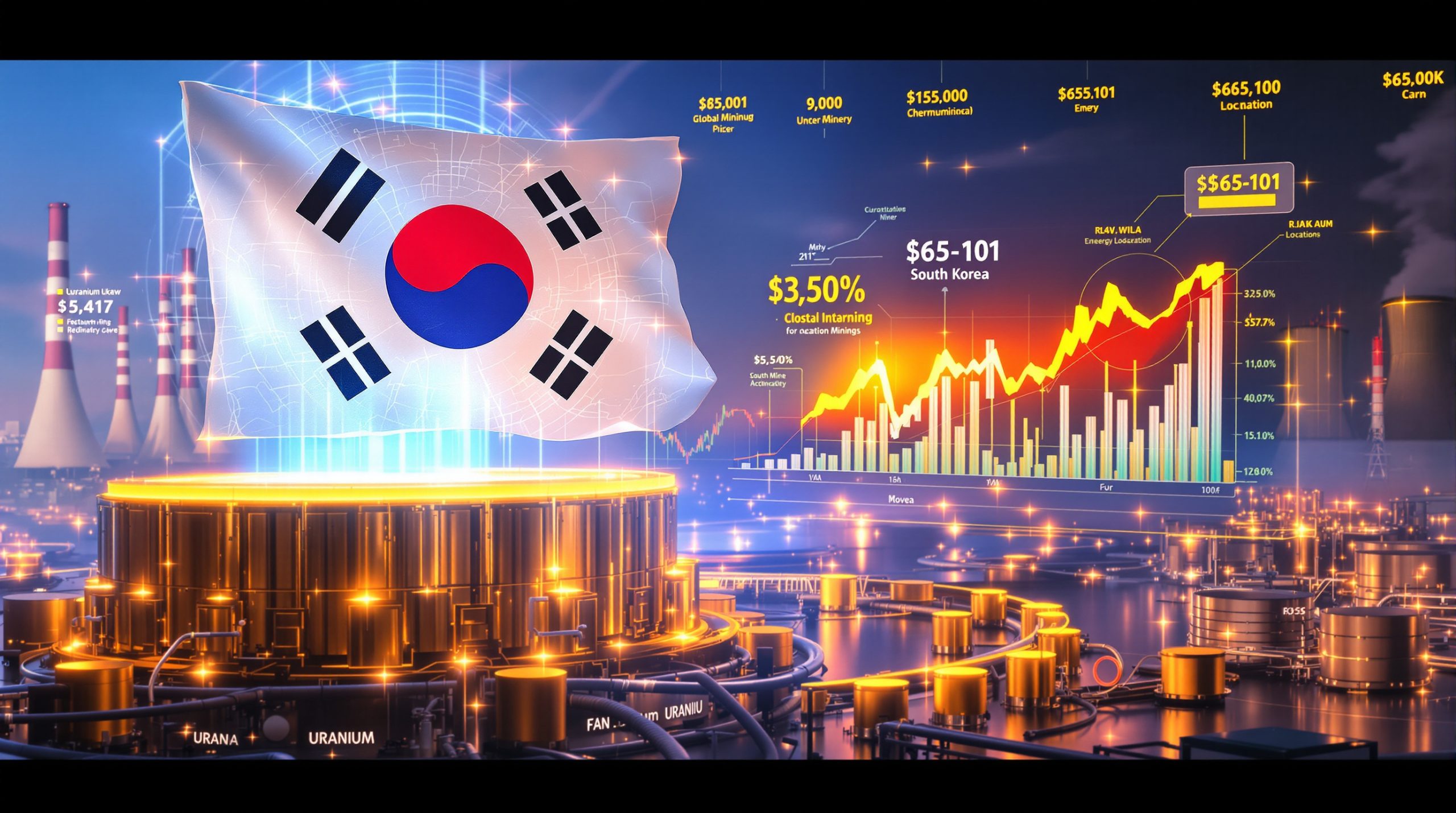The Geopolitical Chess Game: Critical Minerals and NATO Defense Commitments
In today's rapidly evolving geopolitical landscape, critical minerals have emerged as pivotal assets in national security frameworks. The intersection between resource development and defense strategy represents a fundamental shift in how nations conceptualize security preparedness. This transformation reflects a growing recognition that military capability depends not just on hardware and personnel, but on secure supply chains for the materials that make modern defense systems possible.
The Strategic Value of Critical Minerals in National Defense
Critical minerals form the backbone of advanced military technologies, from guidance systems to communications equipment. Their strategic importance extends beyond traditional military applications to encompass defense-critical materials, energy security, technological sovereignty, and economic resilience—all crucial components of a comprehensive national security posture.
Can Resource Development Count Toward NATO Defense Commitments?
Canada's Innovative Approach to Defense Spending
Canada has proposed an innovative policy shift by suggesting critical mineral investments could count toward NATO defense commitments. This creative interpretation effectively equates developing mines and processing facilities with traditional military expenditures, acknowledging that resource security underpins defense capability.
The proposal reflects a growing understanding that modern defense systems cannot function without secure access to key materials. By reframing resource development as a defense investment, Canada has opened a new perspective on alliance contributions.
The Logic Behind Resource-Defense Integration
The rationale for this approach is compelling and multifaceted:
- Material Dependencies: Modern military equipment—from fighter jets to missile systems—relies heavily on rare earths, lithium, nickel, and other critical minerals.
- Supply Chain Vulnerability: Without secure domestic sources of these materials, even the most sophisticated weapons systems become vulnerable to supply disruptions.
- Strategic Independence: Developing national production capabilities reduces dependence on potentially hostile suppliers.
- Dual-Use Benefits: Investments in critical mineral infrastructure serve both defense and civilian economic objectives.
This integration recognizes that in modern warfare, the battle for resources often precedes physical conflict.
NATO's Evolving Spending Targets
With NATO reportedly considering raising spending targets to approximately 5% of GDP, alternative pathways to meet these obligations have gained importance. This increase would represent a significant jump from the current 2% target that many members already struggle to achieve.
The resource-defense integration model offers several advantages:
- Allows members to make meaningful security contributions while simultaneously strengthening economic capacity
- Creates flexibility for resource-rich nations to leverage their natural advantages
- Potentially accelerates development of secure supply chains within alliance territory
- Broadens the concept of security investment beyond traditional military hardware
Several alliance members facing fiscal constraints have expressed interest in this approach, seeing it as a way to balance economic and security imperatives.
How Is China Strengthening Control Over Critical Mineral Supply Chains?
New Regulatory Framework for Rare Earth Materials
China has implemented unprecedented regulations extending state control throughout the rare earth value chain. Recent rules now subject imported rare earth concentrates to the same production quota system governing domestic mines, creating a comprehensive monitoring framework for these strategic resources.
This regulatory expansion represents a significant escalation in Beijing's approach to resource management. Previously, China's quota system applied only to domestic mining operations, but the new framework brings all rare earth materials flowing through China under government oversight.
Centralized Tracking and Production Controls
Under China's enhanced Rare Earth Management regulations, refiners must report detailed monthly data on all rare earth ore—whether domestically produced or imported—into a centralized tracking system. This system gives authorities unprecedented visibility into:
- Total volume of rare earth materials being processed
- Origins of all rare earth concentrates
- Distribution channels for refined products
- Production capacities at individual facilities
This centralized monitoring creates a powerful tool for managing the global rare earth supply chain, as a significant percentage of the world's rare earth reserves analysis pass through Chinese processing facilities.
Strategic Implications of China's Resource Management
This regulatory expansion represents a clear signal that China views critical minerals as strategic assets rather than mere commodities. By extending oversight to include imports, China has created potential new leverage points in the global supply chain.
The implications include:
- Enhanced Supply Chain Control: Beijing can now monitor and potentially restrict the flow of materials more effectively
- Market Intelligence: The reporting system provides Chinese authorities with superior information about global rare earth markets
- Policy Flexibility: With comprehensive data and control mechanisms, China can calibrate its response to international developments
- Negotiating Power: Knowledge of supply chain vulnerabilities strengthens China's hand in trade and diplomatic negotiations
These developments have raised concerns among Western nations about future access to essential materials for both civilian and defense applications.
What Impact Have Chinese Export Controls Had on Global Supply Chains?
Recent Disruptions in Rare Earth Magnet Markets
Earlier this year, China implemented export license controls that significantly disrupted global shipments of high-purity magnet materials. This move, widely interpreted as retaliation for Western technology restrictions, demonstrated China's willingness to leverage its resource dominance as a geopolitical tool.
The export controls primarily targeted neodymium-iron-boron (NdFeB) magnets and the high-purity rare earth oxides used in their production. These materials are essential components in:
- Electric vehicle motors
- Wind turbine generators
- Precision guidance systems for military applications
- Advanced manufacturing equipment
The restrictions created immediate supply challenges for manufacturers in Europe, Japan, and North America who depend on Chinese materials.
Recovery and Ongoing Vulnerabilities
While recent data shows a substantial rebound in Chinese rare earth magnet exports—with July figures jumping nearly 75% from the previous month—the episode highlighted the fragility of global supply chains.
Despite this recovery, several concerning trends persist:
- Year-to-date export volumes remain significantly below previous years
- German imports, while recovering, still have not reached pre-restriction levels
- U.S.-bound volumes, though up 75% month-over-month, reflect an artificially low baseline
- Supply chain participants report continued uncertainty about future access
The temporary easing of restrictions likely reflects pragmatic adjustments rather than a fundamental policy shift, leaving underlying vulnerabilities unresolved.
Industrial Response to Supply Uncertainties
The temporary export restrictions had significant consequences for global manufacturers:
- Some overseas automakers reportedly halted production due to magnet shortages
- Industrial users accelerated efforts to qualify alternative suppliers
- Stockpiling behavior increased, creating secondary market distortions
- Prices for rare earth magnets outside China spiked by double-digits
These disruptions have accelerated Western efforts to develop alternative supply sources and reduce dependency on Chinese materials. Several manufacturers have begun investigating magnet recycling, material substitution, and partnerships with emerging suppliers in Australia, Canada, and the United States.
How Is the United States Countering Chinese Dominance in Critical Minerals?
Human Rights-Based Supply Chain Pressure
The U.S. has intensified scrutiny of Chinese supply chains through human rights enforcement mechanisms. The Department of Homeland Security is now applying the Uyghur Forced Labor Prevention Act (UFLPA) to imports of critical materials including steel, copper, and lithium, creating new compliance challenges for companies sourcing from China.
This approach leverages concerns about forced labor in the Xinjiang region to address broader supply chain vulnerabilities. Materials affected include:
- Lithium compounds used in battery production
- Copper used in electrical systems and renewable energy
- Steel alloys containing critical elements like vanadium and titanium
- Graphite used in battery anodes
Companies importing these materials now face the burden of proving their products are not linked to forced labor—a difficult task given the opacity of Chinese supply chains.
Pentagon's Strategic Investment Approach
In an unprecedented shift toward industrial policy, the U.S. Department of Defense has begun taking equity stakes in critical mineral companies. This approach, exemplified by the Pentagon's deal with MP Materials for rare earth magnet production, signals Washington's commitment to rebuilding domestic supply chains through direct investment.
The strategy includes several components:
- Direct equity investments in strategic companies
- Long-term purchase agreements providing market certainty
- Technical support for processing innovation
- Expedited permitting for projects deemed essential to national security
This approach blends public funding with private expertise to accelerate development in sectors considered vital to defense capabilities.
Potential Beneficiaries of U.S. Strategic Investments
Industry analysts anticipate further Pentagon partnerships with companies across the critical minerals spectrum. Firms developing capabilities in these areas are particularly well-positioned:
- Rare Earth Processing: Companies developing separation and refining capabilities outside China
- Advanced Magnet Manufacturing: Firms establishing production lines for high-performance magnets
- Battery Material Production: Manufacturers of cathode materials, graphite, and other battery components
- Strategic Metal Refining: Companies processing cobalt, nickel, and other defense-critical metals
- Recycling Technologies: Innovative firms recovering critical materials from end-of-life products
Companies with projects in allied nations and those with advanced processing technologies are likely candidates for future support under the US mineral executive order.
What Does Canada's Defense-Resource Integration Model Mean for Global Security?
Redefining Security Assets for the 21st Century
Canada's approach represents a fundamental reconceptualization of what constitutes security infrastructure. By recognizing critical mineral projects as defense assets, this model acknowledges the changing nature of security threats and dependencies in a technology-driven world.
This redefinition expands security considerations to include:
- Resource availability and access
- Processing capabilities and technical knowledge
- Supply chain resilience and redundancy
- Industrial capacity for critical components
This holistic view better reflects the realities of modern conflict, where economic and technological advantages often prove as decisive as traditional military capabilities.
Implications for Resource-Rich NATO Members
For resource-rich NATO members, this integration model offers a pathway to simultaneously strengthen economic development and meet alliance obligations. Countries with significant critical mineral deposits could leverage this approach to:
- Attract investment by highlighting the dual economic and security benefits
- Develop resource sectors with security-focused priorities
- Accelerate permitting for strategically important projects
- Create specialized industrial clusters around defense materials
Nations like Norway (with significant rare earth potential), Turkey (with boron and rare metal reserves), and Portugal (with lithium deposits) could find particular advantage in this approach.
Potential for Broader Application
The Canadian model could inspire similar approaches beyond NATO, potentially reshaping how nations around the world conceptualize the relationship between resource development and national security. This paradigm shift may:
- Accelerate investment in critical mineral projects globally
- Create new frameworks for resource cooperation among allied nations
- Establish new standards for evaluating national security contributions
- Blur traditional distinctions between economic and defense policy
As this model gains traction, it could fundamentally alter how nations view their resource endowments—not just as economic assets, but as core components of national security infrastructure.
How Are Capital Markets Responding to Critical Mineral Security Concerns?
Investment Shifts Toward Secure Supply Chains
Capital markets are increasingly factoring geopolitical considerations into investment decisions regarding critical mineral companies. Firms with projects in allied nations or those engaged with government security programs are attracting premium valuations as investors recognize the strategic advantage of "secure" supply.
This shift reflects growing awareness that:
- Geopolitical factors can override traditional economic considerations
- Government support significantly reduces project development risks
- "Friendly jurisdiction" assets may command price premiums
- Strategic positioning can be as valuable as technical fundamentals
Investment flows increasingly favor projects with clear security narratives, even when they may have higher costs than alternatives in less geopolitically favorable locations.
The Rise of "National Security" Premium
Companies positioned to benefit from government support programs are experiencing heightened investor interest. This trend reflects growing recognition that critical minerals strategic reserve assets may receive preferential treatment, funding, and regulatory support when framed as national security infrastructure.
The "national security premium" manifests in several ways:
- Higher valuation multiples for companies with security-oriented positioning
- Increased institutional investment in previously overlooked mineral sectors
- Greater tolerance for longer development timelines when supported by strategic narratives
- Preference for jurisdictional security over absolute cost advantages
Industry executives report spending significant time in Washington and other allied capitals, seeking government endorsement that can translate into market advantage—a dramatic shift from previous years when such companies struggled to gain political attention.
Changing Risk Assessment for Resource Projects
Traditional project evaluation metrics are being supplemented with geopolitical risk assessments that consider a project's alignment with national security objectives. This evolution in investment criteria may advantage certain jurisdictions and project types over others.
Factors gaining prominence in risk assessments include:
- Jurisdictional Security: Location within allied nations or stable democracies
- Supply Chain Integration: Connections to defense industrial bases
- Government Relationships: Engagement with security agencies and programs
- Strategic Positioning: Relevance to specific defense or technology applications
Projects that score highly on these factors may secure financing even when traditional metrics like grade or cost position are less competitive, reflecting the market's evolving understanding of value in a security-conscious environment.
What Role Will Public-Private Partnerships Play in Critical Mineral Security?
Evolution of Government-Industry Collaboration
The critical minerals sector is witnessing unprecedented collaboration between government agencies and private companies. These partnerships blend public funding with private expertise to accelerate development of strategic resource projects.
Key features of these evolving partnerships include:
- Risk Sharing: Governments absorb some development and market risks
- Technical Collaboration: Sharing of research and development capabilities
- Market Guarantees: Long-term purchase agreements providing certainty
- Regulatory Facilitation: Streamlined approvals for strategic projects
This collaborative approach represents a significant departure from traditional arm's-length relationships between resource companies and governments.
Defense Production Act as a Catalyst
In the United States, the Defense Production Act has emerged as a key mechanism for facilitating public-private partnerships in critical minerals. This framework allows for direct government support of private sector initiatives deemed essential to national security.
The DPA enables several powerful interventions:
- Direct financial investments in production facilities
- Purchase commitments guaranteeing markets for output
- Prioritization of materials for government use
- Coordination of industrial capabilities across multiple companies
Projects supported under this mechanism gain both financial advantages and significant market credibility, often leading to easier access to additional private capital.
International Coordination Opportunities
Beyond national initiatives, there are growing opportunities for international public-private partnerships that align allied nations' resources and capabilities. These collaborative approaches may prove essential in developing alternatives to Chinese-dominated supply chains.
Emerging models include:
- Multi-nation Funding Consortia: Pooled government resources supporting strategic projects
- Technology Transfer Agreements: Sharing processing innovations across allied nations
- Harmonized Regulatory Frameworks: Coordinated approval processes for cross-border projects
- Joint Stockpiling Programs: Shared strategic reserves of critical materials
These international collaborations could create more robust alternatives to existing supply chains while distributing costs and risks across multiple partners.
How Might Critical Mineral Strategies Affect Global Trade Patterns?
Reshaping of Global Supply Networks
The politicization of critical mineral supply chains is driving fundamental changes in global trade patterns. "Friend-shoring" and nearshoring strategies are redirecting investment flows toward politically aligned nations, potentially creating new regional resource hubs.
This reshaping manifests in several ways:
- Investment Redirection: Capital flowing to projects in allied nations rather than lowest-cost locations
- Processing Relocation: New refining and processing facilities being built in secure jurisdictions
- Contract Restructuring: Long-term supply agreements increasingly incorporating security provisions
- Technical Standards Divergence: Separate specifications emerging for different geopolitical blocs
The cumulative effect could be a significant reorganization of global mineral flows along geopolitical rather than purely economic lines.
Emerging Trade Blocs Around Strategic Resources
As nations prioritize secure access to critical minerals, new trade relationships centered on these resources are forming. These emerging blocs may reinforce broader geopolitical alignments and create new interdependencies among allied countries.
Several patterns are becoming evident:
- Quad Resources Initiative: Australia, Japan, India, and the U.S. coordinating critical mineral strategies
- European Critical Materials Alliance: EU member states harmonizing resource security approaches
- Five Eyes Minerals Cooperation: Intelligence-sharing nations extending collaboration to resource security
- ASEAN Minerals Framework: Southeast Asian nations developing regional resource strategies
These groupings create preferential trade channels that may eventually solidify into more formal arrangements with implications beyond the minerals sector.
Potential for Trade Friction and Dispute
The strategic importance attached to critical minerals energy security increases the likelihood of trade disputes related to these resources. Export restrictions, subsidy programs, and preferential procurement policies may all become sources of international tension.
Potential flashpoints include:
- Export Controls: Restrictions on shipments of raw or processed materials
- Subsidy Challenges: WTO disputes over government support for domestic producers
- Technical Barriers: Specifications designed to favor domestic or allied suppliers
- Investment Screening: Blocking of acquisitions based on national security concerns
As critical minerals become more central to economic and security strategies, these tensions could escalate into significant trade conflicts that test existing international governance frameworks.
What Are the Long-Term Implications of Militarizing Resource Policy?
Blurring Lines Between Economic and Security Policy
The integration of critical minerals into defense frameworks represents a significant blurring of traditional boundaries between economic and security policy. This convergence creates both opportunities and challenges for international cooperation and competition.
Key implications include:
- Policy Coordination Challenges: Requiring unprecedented alignment between economic, industrial, and defense agencies
- Market Distortions: Security priorities potentially overriding market signals and efficient allocation
- Regulatory Complexity: Creating conflicting mandates for oversight bodies
- Diplomatic Ambiguity: Complicating trade negotiations with security considerations
This blurring may require new institutional frameworks capable of balancing legitimate security concerns with economic efficiency and open markets.
Risks of Resource Nationalism and Conflict
As critical minerals become increasingly securitized, there is heightened risk of resource nationalism and potential conflict over access to key deposits. Nations may take more aggressive stances to secure supplies they deem essential to national security.
Concerning trends include:
- Accelerating Nationalization: Government takeovers of strategic mineral assets
- Territorial Disputes: Intensified conflicts over regions with critical mineral deposits
- Proxy Competition: Support for non-state actors controlling resource-rich areas
- Preemptive Control: Strategic acquisition of resources beyond immediate needs
Historical examples suggest that resource competition can escalate from economic to military confrontation when materials are viewed as existentially important.
Need for New Governance Frameworks
The evolving landscape calls for new international governance frameworks that can balance legitimate security concerns with the benefits of open trade. Developing these mechanisms will require careful diplomacy and recognition of diverse national interests.
Potential approaches include:
- Critical Minerals Security Forums: Dedicated international bodies for resource cooperation
- Supply Chain Transparency Initiatives: Frameworks for monitoring material flows
- Dispute Resolution Mechanisms: Specialized processes for addressing resource conflicts
- Crisis Response Protocols: Procedures for managing acute supply disruptions
Without such frameworks, the risk increases that critical mineral competition will exacerbate rather than mitigate international tensions.
Navigating the New Mineral Security Paradigm
The integration of critical minerals into national security frameworks represents a fundamental shift in how nations conceptualize both resource development and defense preparedness. This evolution creates new strategic imperatives for governments, opportunities for resource companies, and challenges for international cooperation.
As this new paradigm takes shape, successful navigation will require:
- Innovative policy approaches that balance security needs with economic efficiency
- Strategic public-private partnerships that accelerate resource development
- International coordination mechanisms that prevent destructive competition
- Investment strategies that recognize the changing risk landscape
The countries and companies that adapt most effectively to this new mineral security paradigm will gain significant advantages in both economic development and strategic positioning in the coming decades.
Ultimately, investments in critical minerals and NATO defense commitments are increasingly being viewed through a dual lens of economic opportunity and national security necessity. This perspective is reshaping global resource flows, corporate strategies, and international relations in ways that will have profound implications for decades to come.
Ready to Invest in the Next Major Mineral Discovery?
Discover why strategic mineral discoveries generate substantial returns by exploring Discovery Alert's dedicated discoveries page, which showcases historic examples of exceptional market outcomes powered by the proprietary Discovery IQ model. Begin your 30-day free trial today at https://discoveryalert.com.au/discoveries/ to position yourself ahead of the market.




